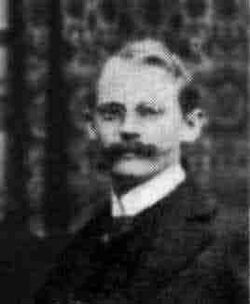Biography:Felix Bernstein (mathematician)
Felix Bernstein | |
|---|---|
 | |
| Born | Halle |
| Died | 3 December 1956 (aged 78) Zurich |
| Alma mater | University of Göttingen |
| Known for | Schröder–Bernstein theorem |
| Children | Marianne Bernstein-Wiener[1]:7r |
| Scientific career | |
| Theses |
|
| Doctoral advisor | David Hilbert |
Felix Bernstein (24 February 1878 in Halle, Germany – 3 December 1956 in Zürich, Switzerland ), was a German Jewish mathematician known for proving in 1896 the Schröder–Bernstein theorem, a central result in set theory,[1]:5–6[2][3][note 1] and less well known for demonstrating in 1924 the correct blood group inheritance pattern of multiple alleles at one locus through statistical analysis.
Life
Felix Bernstein was born in 1878 to a Jewish family of academics.[4] His father Julius held the Chair of Physiology at the Martin Luther University of Halle-Wittenberg, and was the Director of the Physiological Institute at the University of Halle.
While still in gymnasium in Halle, Bernstein heard the university seminar of Georg Cantor, who was a friend of Bernstein's father.[1]:5r From 1896 to 1900, Bernstein studied in Munich, Halle, Berlin and Göttingen.[5]:166 In the early Weimar Republic, Bernstein temporarily was Göttingen vice-chairman of the local chapter of German Democratic Party .[6]:7[7]:118[8] In 1933,[note 2] after Hitler's rise to power, Bernstein was removed from his chair, per §6 of the Nazi Law for the Restoration of the Professional Civil Service, often used against politically unpopular persons. He received the message of his dismissal during a research/lecturing journey (started on Dec. 1st, 1932) to the United States, and he stayed there.[5]:166[6]:7–8[8] He was a visiting professor of mathematics at Columbia University from 1933 to 1936 and a professor of biometry at New York University from 1936 to 1943.[9] In 1942 he was elected a fellow of the American Association for the Advancement of Science.[10] In 1948, Bernstein retired from teaching in the US, and returned to Europe.[2] He mainly lived in Rome and Freiburg, occasionally visiting Göttingen,[5]:166 where he became professor emeritus.[2] He died of cancer[citation needed] in Zurich on 3 December 1956.[1]:6r[2]
Publications
- Felix Bernstein (1903). Über den Klassenkörper eines algebraischen Zahlkörpers (Habilitation thesis). Univ. Göttingen.
- Felix Bernstein (1905). "Untersuchungen aus der Mengenlehre". Mathematische Annalen 61: 117–155. doi:10.1007/bf01457734. http://gdz.sub.uni-goettingen.de/index.php?id=11&PPN=PPN235181684_0061&DMDID=DMDLOG_0015&L=1. Retrieved 2014-02-01. (Dissertation, 1901); reprint Jan 2010, ISBN:1141370263
- Felix Bernstein (1905). "Über die isoperimetrische Eigenschaft des Kreises auf der Kugeloberfläche und in der Ebene". Mathematische Annalen 60: 117–136. doi:10.1007/bf01447496. http://www.digizeitschriften.de/download/PPN235181684_0060/log9.pdf.
- Felix Bernstein (1905). "Über die Reihe der transfiniten Ordnungszahlen". Mathematische Annalen 60 (2): 187–193. doi:10.1007/bf01677265. http://www.digizeitschriften.de/download/PPN235181684_0060/log23.pdf.
- Felix Bernstein (1905). "Die Theorie der reellen Zahlen". Jahresbericht der Deutschen Mathematiker-Vereinigung 14: 447–449. http://www.digizeitschriften.de/download/PPN37721857X_0014/log113.pdf.
- Felix Bernstein (1905). "Zum Kontinuumproblem". Mathematische Annalen 60 (3): 463–464. doi:10.1007/bf01457626. http://www.digizeitschriften.de/download/PPN235181684_0060/log49.pdf.
- Felix Bernstein (1907). "Über das Gaußsche Fehlergesetz". Mathematische Annalen 64 (3): 417–448. doi:10.1007/bf01476025. http://www.digizeitschriften.de/download/PPN235181684_0064/log43.pdf.
- Felix Bernstein (1907). "Zur Theorie der trigonometrischen Reihe". Journal für die reine und angewandte Mathematik 132: 270–278. http://www.digizeitschriften.de/download/PPN243919689_0132/log21.pdf.
- Felix Bernstein (1919). "Die Mengenlehre Georg Cantors und der Finitismus". Jahresbericht der Deutschen Mathematiker-Vereinigung 28: 63–78. http://www.digizeitschriften.de/download/PPN37721857X_0028/log10.pdf.
- Felix Bernstein (1919). "Die Übereinstimmung derjenigen beiden Summationsverfahren einer divergenten Reihe, welche von T.E. Stieltjes und E. Borel herrühren". Jahresbericht der Deutschen Mathematiker-Vereinigung 28: 50–63. http://www.digizeitschriften.de/download/PPN37721857X_0028/log9.pdf. — Corrections in Vol.29 (1920), p. 94
- Felix Bernstein (1923). "Zur Statistik der sekundären Geschlechtsmerkmale beim Menschen". Nachrichten von der Gesellschaft der Wissenschaften zu Göttingen, Mathematisch-Physikalische Klasse 1923: 89–95. http://www.digizeitschriften.de/download/PPN252457811_1923/log15.pdf.
Notes
- ↑ In 1897 (aged 19), according to Oliver Deiser (2010). "Zeittafel zur frühen Mengenlehre". Einführung in die Mengenlehre — Die Mengenlehre Georg Cantors und ihre Axiomatisierung durch Ernst Zermelo (3rd ed.). Heidelberg: Springer. ISBN 978-3-540-20401-5. https://link.springer.com/content/pdf/bbm%3A978-3-642-01445-1%2F1.pdf.
- ↑ In 1934, according to O'Connor, Robertson (MacTutor).
See also
References
- ↑ 1.0 1.1 1.2 1.3 Crow, J. F. (1993). "Felix Bernstein and the first human marker locus". Genetics 133 (1): 4–7. doi:10.1093/genetics/133.1.4. PMID 8417988.
- ↑ 2.0 2.1 2.2 2.3 O'Connor, John J.; Robertson, Edmund F., "Felix Bernstein (mathematician)", MacTutor History of Mathematics archive, University of St Andrews, http://www-history.mcs.st-andrews.ac.uk/Biographies/Bernstein_Felix.html.
- ↑ Nathan, Henry (1970–1980). "Bernstein, Felix". Dictionary of Scientific Biography. 2. New York: Charles Scribner's Sons. pp. 58–59. ISBN 978-0-684-10114-9.
- ↑ "Felix Bernstein". International Statistical Review (2005), 73: 1. 3-7.
- ↑ 5.0 5.1 5.2 Max Pinl (1970). "Kollegen in einer dunklen Zeit (2)". Jahresbericht der Deutschen Mathematiker-Vereinigung 72: 165–189. http://www.digizeitschriften.de/download/PPN37721857X_0072/log14.pdf.
- ↑ 6.0 6.1 Norbert Schappacher (1987). "Das Mathematische Institut der Universität Göttingen 1929—1950". in Becker. Die Universität Göttingen unter dem Nationalsozialismus. München: K.G.Saur. pp. 345–373. http://www-irma.u-strasbg.fr/~schappa/NSch/Publications_files/GoeNS.pdf. — Schappacher gives a lot of details from the Göttingen University archive.
- ↑ Barbara Marshall (1972). The Political Development of German University Towns in the Weimar Republic: Göttingen and Münster 1918—1930 (Ph.D. thesis). Univ. of London.
- ↑ 8.0 8.1 Steffi Laemmle; Willy Tiabou; Christoph Bichlmeier (May 2003). Seminar für überfachliche Grundlagen: Mathematiker in der NS-Zeit (Term Paper).
- ↑ Cattell, Jaques, ed (1949). American Men of Science: A Biographical Dictionary. Lancaster, Pennsylvania: The Science Press. p. 192. https://books.google.com/books?id=Ea9CC4lCicQC&pg=PA192.
- ↑ "Historic Fellows". https://www.aaas.org/fellows/historic.
External links
- Biography at the Felix-Bernstein-Institute for Mathematical Statistics in the Biosciences at the Göttingen University
- Felix Bernstein at the Mathematics Genealogy Project
 |

